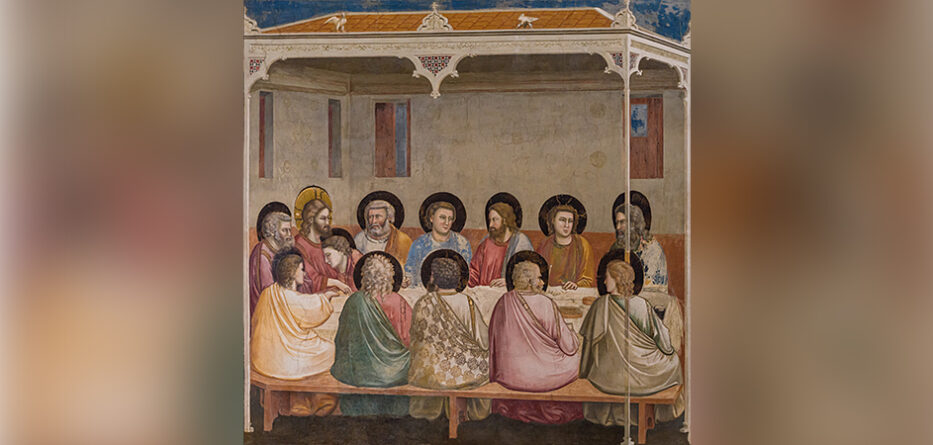Palm Sunday of the Passion of the Lord
Readings: Mark 11:1–10; Isaiah 50:4–7; Psalm 21 (22):8–9,17–20,23–24; Philippians 2:6–11; Mark 15:1–39
24 March 2024
SPIRITUAL REFLECTION with Katherine Stone MGL
There’s a story told about yet another flight cancellation where a single member of staff was left rebooking a long line of inconvenienced travellers when one angry passenger pushed to the front of the line insisting that he be served immediately and given a first-class seat on the next flight out. The staffer replied, “I am sorry sir! I’ll be happy to try to help you, but you’ll have to take your place in the line, and I’m sure we’ll be able to work something out.” Unimpressed, the passenger shouted, “Do you have any idea who I am?” Without hesitating, the staffer grabbed her microphone and announced through the terminal, “May I have your attention, please! We have a passenger here at Gate 14 who does not know who he is. If anyone can help with this, please come to Gate 14.”
On Palm Sunday, in the first Gospel reading, Jesus appears to break the same societal rules around humility and not putting oneself forward. Even if I know I’m the best in the room, our cultural norms would say that it’s not polite to draw attention to that fact, and I should probably offer a modest protest if someone else does. Here, Jesus seems to not only just accept, but actively set the scene for the adulation of the crowds. How does that fit with someone who preaches that humility means taking the lowest place?
Teresa of Ávila reminds us that humility is truth. Today, the crowds get it right: Jesus is the Messiah. Knowing this to be true, Jesus humbly accepts their instinctive response: “Blessed is he who is coming in the name of the Lord!” (Mk 11:9).
But the truth is bigger than they know. Jesus is in fact the Messiah, the one who has come to save them, but not from Roman rule. There is more to be revealed about Jesus’ identity.
A week later, before the Sanhedrin, Jesus admits to a deeper truth about who he is: Jesus is the Son of God. In response to such a shocking claim, the crowds are loud with a different cry: “Crucify him! Crucify him!” (Jn 19:6)
Jesus knew the Jewish Law. He knew that claiming to be God would lead to his death. He also knew that by dying, he would save us all. Jesus, knowing who he was, and what it would cost to admit it, consciously chose the cross. Why? For love of us.
Which means that these stories also reveal some truths about yours and my identity.
As those processing with palm branches into our parish churches on this day, we, too, are members of the crowd who acclaim Jesus as our Messiah.
As those taking part in the Passion not once, but probably twice this week, we are also members of the crowd who reject him as our King.
As those for whom Jesus willingly died, however, the most important truth about our identity, a truth that we can own in all humility, is that we are the beloved of God.
As we move into the celebration of Easter, ultimately what we are celebrating is the utterly humbling reality that God loves us despite the fact that we don’t really grasp who he is; despite the fact that we reject him. As the second reading reminds us, he chose to leave the comforts of heaven to share our human experience, and then, even to give up his life—all for love of us.
Perhaps as we move into Holy Week and the Triduum we can allow this truth to be the lens through which we see all that takes place.
REFLECTING ON THE READINGS THROUGH ART with Mgr Graham Schmitzer
No. 29 Scenes from the Life of Christ—13. Last Supper – Giotto di Bondone (1266–1337)
“No. 29 Scenes from the Life of Christ—13. Last Supper” (c. 1304–1306), Fresco, 200cm x 185cm. Scrovegni Chapel, Padua, Veneto, Italy. Public Domain.
Perhaps we can grasp the essence of God’s love or pity best in devotion to the Sacred Heart of Jesus. This devotion suffered a setback after the Second Vatican Council, but only by those who never fully grasped its meaning. Some saw as overly sentimental the image of a Man “wearing his heart on his sleeve”, as it were.
And yet, the whole Gospel of St John comes to a climax with the piercing of Christ’s side, and the blood and water gushing forth, seen by the early Fathers as a symbol of the birth of the Church. John quotes the amazing prophecy of Zechariah (Zc 12:10): “They shall look on him whom they have pierced” (Jn 19:37).
In one of his meditations, Pope Benedict XVI saw the pierced Heart of the Crucified as God speaking a word to us, a word carved out by the soldier’s lance in the very flesh of Jesus’ side. Here is the love of God laid bare for all to see. It is God stepping out of his hiddenness. In the wounding of Christ’s Heart, God utters a poem of love. This is the meaning of love, says St John: “Not that we loved God, but that he loved us, and sent his Son to be the expiation for our sins” (1 Jn 4:10).
“The opening of the Heart is the handing over of what is most intimate and personal for the use of all,” wrote the modern theologian, Hans Urs von Balthasar (The Opening of the Heart). Christ has kept back nothing of himself. He has taken the risk of love.
But in order to “read” this poem inscribed in the flesh of the Word of God, we have to stop in front of it and look long at the wound made by love. “They shall look on him whom they have pierced” (Jn 19:37). We must look, not with a passing glance, but with the gaze of someone who has been conquered by love. “You have seduced me Lord”, said Jeremiah “and I have let myself be seduced; you are stronger than I, and you have prevailed” (Jr 20:7).
Everything we have ever wanted to say to God has already been said, and is still being said, by Christ’s pierced Heart in heaven. The Letter to the Hebrews tells us: “Christ is able for all time to save those who draw near to God through him, since he lives for ever to make intercession for them” (Heb 7:25). Christ exercises this power of intercession by presenting to the Father the glorious wounds in his hands, his feet, and his side—wounds which have never healed according to the testimony of St John on Easter night (Jn 20:20), and on the Sunday following (Jn 20:27).
The wound in the side of Christ, our great High Priest, speaks to the Father on our behalf. Devotion to the Sacred Heart is a long apprenticeship whereby, in silence, we begin to let the Heart of Christ speak in us, and for us, to the Father. He understands us and our needs perfectly, says the same Letter to the Hebrews, because “in every respect [he] has been tempted as we are, yet without sin” (Heb 4:15).
Catherine of Siena was fascinated by this wound in Christ’s side, revealing his Sacred Heart. The soldier’s lance seems to have hit the heart, evidenced by the flowing forth of blood and the clear liquid surrounding the heart (evidenced by the stain on the Shroud of Turin.) St John describes this as “water” (Jn 19:34). The Heart had shed the very last drop of its blood.
Catherine decided to ask Our Lord why he had allowed this to happen, if indeed his very death was our redemption. What more was needed? The opening of the heart was after death. She relates that Jesus answered that his suffering on the cross lasted only for so long, but his love is infinite. “I wanted you to see the secret of my Heart by showing it to you open, so that you would see that I loved you more than I could have shown you with finite suffering.” And Catherine reflects: “This open side, where human beings are awaited so they can be sheltered there in tenderness, is described as a bridal suite…. God closed Adam’s side again, after having taken Eve from it. Catherine saw Christ’s side always open, so that humanity could always enter there, purify itself of its offences, satisfy itself, and unite itself to the divinity” (as narrated by Chantal van der Plancke and André Kockaert in 15 Days of Prayer with Catherine of Siena.)
Christ’s prayer for us to his Father which filled the days and nights of his earthly life, and which continues uninterrupted in heaven, is ceaseless in the Sacrament of the Altar. In the final analysis, Christ’s message to us is in the language of love. It cannot be learned in conferences, or classrooms, or books, any more than earthly love can. It can only be learned in silence and contemplation. It is learned especially in the presence of the Blessed Sacrament.
According to St Thomas Aquinas, Jesus is present in the Blessed Sacrament in the same attitude as he is present in heaven—interceding for us with his Father. His presence, then, is not a static presence, but a dynamic presence. We enter his eternal “conversation” when praying before the tabernacle or the monstrance.
In his meditation on the meaning of devotion to the Sacred Heart, Pope Benedict XVI suggested a little prayer which we can all say:
Lord Jesus, I come to be silent in your presence, trusting that your Heart will speak for me, knowing that all I could ever want to say, that all I would ever need to say, is spoken continually to the Father by your Sacred Heart.
During the High Renaissance, Giotto was widely acknowledged as one of the key figures who laid the foundation for the artistic movement. His skills in painting played a crucial role in revitalising the arts as a whole. Giotto achieved this by skilfully blending his own talent with a deep understanding of the teachings passed down from the ancient masters. One of his notable contributions was his ability to accurately, and dramatically, depict the proportions and anatomical intricacies of the human body. This mastery of representing the human form in a lifelike and compelling manner helped to elevate the art of painting during that time. Leonardo da Vinci, Michaelangelo and Raphael, over a hundred years later, would all study his work.
Giotto was born into a humble family probably about 1266. He became an apprentice to Cimabue in Florence. It was Cimabue who painted the first portrait of St Francis. Giotto’s most renowned masterpiece is widely regarded as the frescoes found in the Scrovegni Chapel located in Padua—38 scenes forming two cycles of the lives of Jesus and Mary. Reginaldo Scrovegni was a notorious moneylender in the city, so infamous that Dante even mentioned him in his Inferno. In an act of atonement, Reginaldo’s son, Enrico, constructed the chapel, most likely as a gesture of repentance. As a fitting dedication, the chapel was offered to Our Lady of Charity.
This detail from the scene of the Last Supper shows Our Lord answering the apostles’ questions as to who it is that is going to betray him. “It is the one to whom I give the piece of bread that I dip in the dish” (Jn 13:26). In supreme contrast, Giotto has placed John on one side of Jesus, resting on his breast, and Judas on the other, dipping his hand in the bowl. During the Middle Ages, the colour yellow was often seen as a symbol of deception. In this artistic representation, Judas is portrayed wearing a yellow robe to emphasise his role as a betrayer.
John, the beloved disciple, rests his head on Jesus’ bosom, some say listening to the secrets of Christ’s Heart. John does not refer to himself in the Gospel, for each of us is meant to be the beloved disciple. Each of us is “the one Jesus loved”. That is why St Paul gives Christ’s personal titles, Chosen and Beloved, to all true believers. “You are God’s chosen ones, holy and beloved” (Co1 3:12).
To be in someone’s bosom is to be in their love, as an intimate friend. St Luke makes this reference in his narration of the parable of Dives and Lazarus. Lazarus, who had starved at the rich man’s gate, now rests in Abraham’s bosom at the messianic banquet of heaven (Lk 16:23). To be in Abraham’s bosom is to be his intimate friend. But this is to be a friend of God himself, for Abraham is “God’s beloved” (Dn 3:35). To reach Abraham’s bosom as he dines in intimacy with God, we must abide in the love of Jesus. This we do especially in the Eucharistic banquet, the foretaste of heaven.
Katherine Stone MGL is a Missionaries of God’s Love (MGL) sister living in Varroville, NSW. Originally hailing from Tasmania, she joined the MGL Sisters in 2005. Since then, she has lived in Canberra, Melbourne and Sydney, studied theology and spiritual direction, and has done a term as formator. These days, her main ministries are spiritual direction, talks and teaching, and retreat giving. She is also the MGL sisters’ vocations director. Her passion is Jesus—as may be apparent from her ministry, she loves talking about him and to him, and hearing others share their own experiences of him.
Monsignor Graham Schmitzer is the retired parish priest of Immaculate Conception Parish in Unanderra, NSW. He was ordained in 1969 and has served in many parishes in the Diocese of Wollongong. He was also chancellor and secretary to Bishop William Murray for 13 years. He grew up in Port Macquarie and was educated by the Sisters of St Joseph of Lochinvar. For two years he worked for the Department of Attorney General and Justice before entering St Columba’s College, Springwood, in 1962. Mgr Graham loves travelling and has visited many of the major art galleries in Europe.
With thanks to the Diocese of Wollongong, who have supplied this reflection from their publication, Pietà – Lenten Program 2024. Reproduced with permission.








